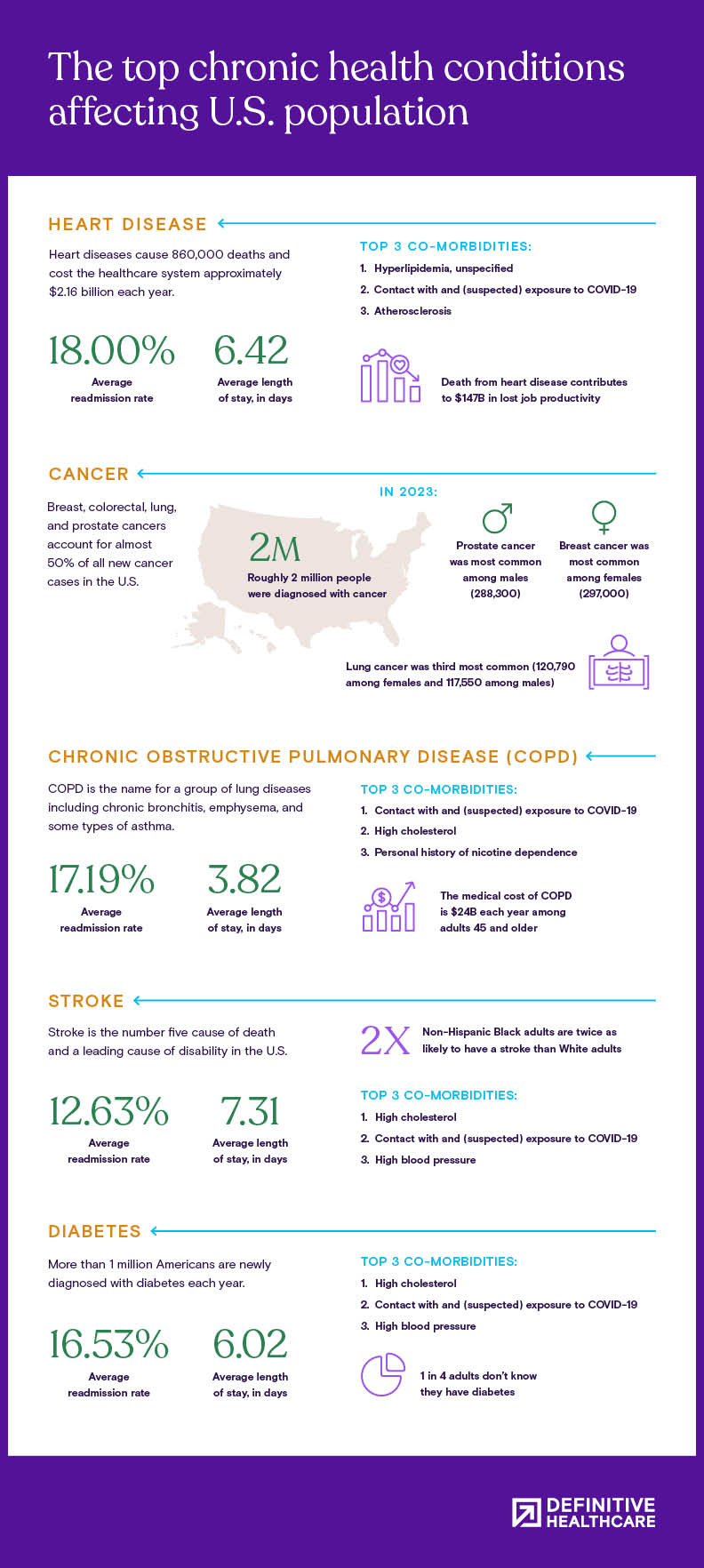Top chronic health conditions impacting population health
Share this post
Living with chronic health conditions poses unique challenges for patients, requiring them to navigate a landscape of ongoing care and management. Because chronic diseases often last a person’s lifetime, proactive measures are needed to ensure a better quality of life.
In this blog, we’ll dig into what chronic health conditions are, the impact they can have, and why it’s crucial to manage and treat them effectively.
What are chronic conditions?
Chronic health conditions are ailments that persist over an extended period, often lasting for months to a lifetime. Unlike acute illnesses that resolve with treatment, chronic diseases necessitate ongoing care, making them a significant aspect of healthcare worldwide.
Common chronic conditions include heart disease, diabetes, arthritis, Alzheimer’s, and some mental health disorders.
Treating and managing chronic conditions is often a complex, challenging undertaking. Many chronic diseases are the leading cause of death or disability in the U.S., and the risk of developing another chronic condition increases if the patient already has one.
As part of treating certain chronic conditions, healthcare professionals often work with their patients in developing a chronic disease management plan. These plans typically consist of activities and behavioral or lifestyle changes to reduce the symptoms of an existing chronic condition or the likelihood of developing one. Ultimately, the goal is to help patients with chronic disease or at-risk have a higher quality of life and live more independently.
What are the most common chronic diseases?
According to the CDC, six out of 10 adults in the U.S. live with a chronic disease, and four in 10 adults have more than one condition. Below, we used healthcare commercial intelligence from the Atlas All-Payor Claims dataset and external sources to determine five of the most common chronic health conditions and explore some recent trends surrounding them.

Chronic disease management market trends
The prevalence and strain of chronic conditions reverberate across both the healthcare industry and the broader economy. This burden, and the challenges chronic care encompasses, have prompted healthcare providers, businesses, the federal government, and other organizations to develop new ways to diagnose, treat, and manage chronic disease.
Two trends in the chronic care space growing in popularity are remote patient monitoring and the ‘food is medicine’ movement.
New technologies and devices are making it easier and more convenient for patients with chronic conditions to receive treatment and engage with their doctors. For example, patients living with diabetes or heart disease can use blood glucose meters, weight scales, blood pressure monitors, and other devices to report various clinical metrics to their providers, all without leaving their homes.
The food you eat can also play an important role in disease management and prevention. The food is medicine movement targets the underlying causes of many of the most common chronic conditions: high blood pressure, high cholesterol, lack of physical activity, excessive alcohol and/or tobacco use, and more. The aim of this healthcare approach is to reduce chronic disease by improving access to nutrition resources, encouraging investing in medically tailored meal programs, and addressing food insecurity in communities.
Innovative solutions to treating and managing chronic conditions can also help relieve the enormous financial impact these diseases have on the economy.
Conditions like diabetes, hypertension, and obesity require ongoing medical attention, often leading to significant healthcare costs. The CDC estimates that chronic diseases (and mental health conditions) account for 90% of U.S. healthcare spending—about $4.1 trillion annually. For employers, chronic conditions also represent a significant threat to workforce productivity, leading to billions in lost income. And, of course, having a chronic condition can severely impact a person’s income and deplete their savings. It’s clear that new technologies, policies, strategies, and ways of thinking about chronic conditions are needed to combat this issue.
Many chronic diseases are preventable
Although common and costly, many chronic diseases are also preventable. Many chronic conditions are linked to lifestyle choices that are within a patient’s own hands to change. Eating healthy, sleeping well, knowing your family history, and exercising regularly can all help lower one’s risk of developing a chronic condition and can help address the symptoms of them. The CDC offers a range of helpful resources for preventing chronic diseases.
Interested in more trends in chronic conditions? Want to get hands-on with the data used in this blog? Then sign up for a free trial today to see how healthcare commercial intelligence can help you understand the chronic disease market better.
